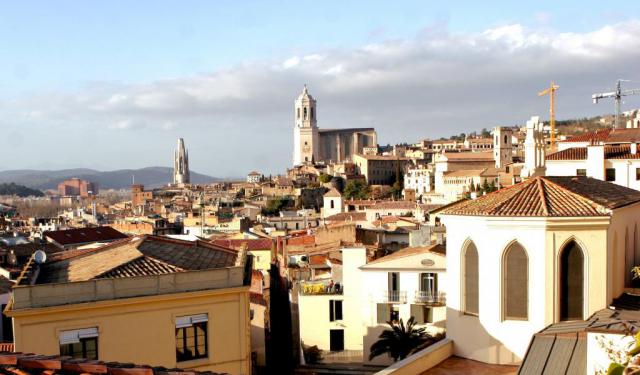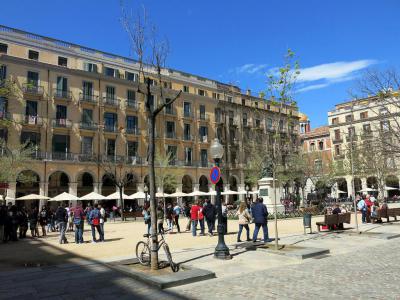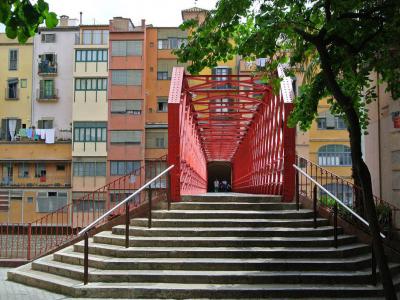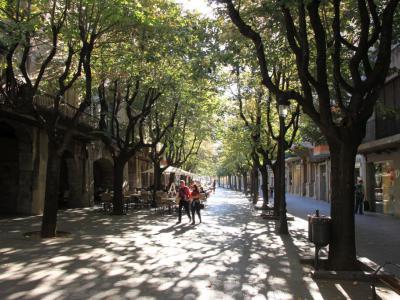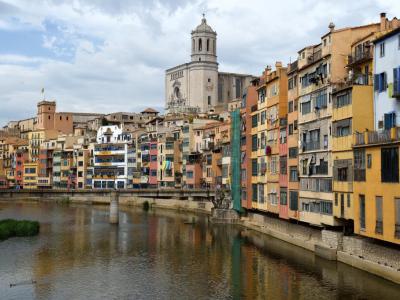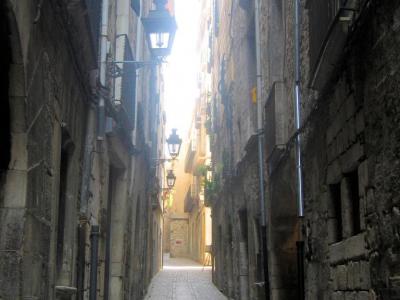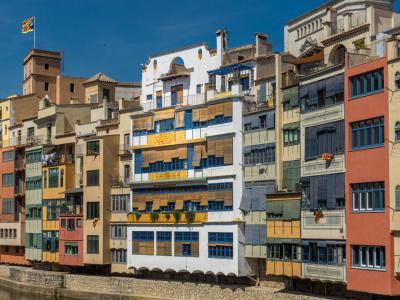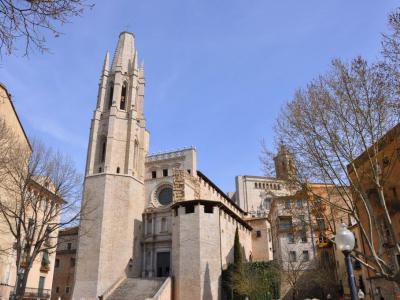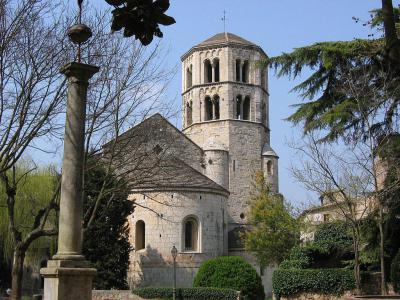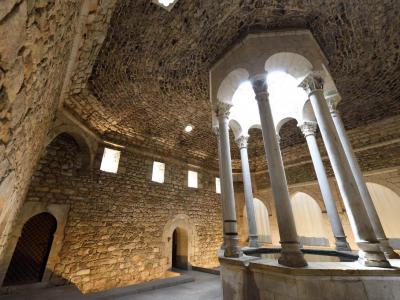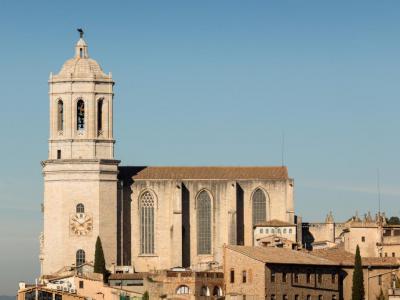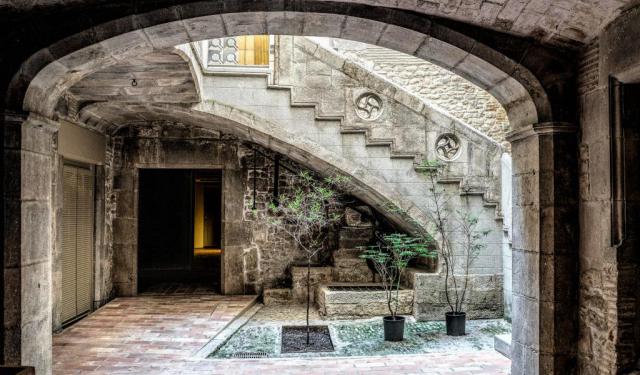Audio Guide: Girona Introduction Walking Tour (Self Guided), Girona
Girona sits in northeastern Catalonia, where every cobblestone seems to gossip about old allegiances and bitter defeats. Long before tourist maps and cafe terraces, Iberian tribes pitched up here in the 6th century BC. The Romans soon followed, stamping the place with the name Gerunda-“near the river”-a practical nod to the Onyar River, which still slices the city neatly into old and new.
From there, Girona became less a hometown and more a prize in a tug-of-war. Visigoths, Moors, Franks-each took their turn, layering cultures like coats of paint. Its prime position near the Pyrenees made it valuable, but also cursed: the city endured more than twenty sieges, enough to earn the grim title “the city of a thousand sieges.” The most famous came in 1809, when Girona held Napoleon’s forces at bay for seven months. Starving, disease-ridden, and ultimately defeated, the city still turned that ordeal into a symbol of Catalan grit.
But not all of Girona’s past is written in blood and brick. In the Middle Ages it thrived as a centre of trade and religion. Its Jewish Quarter, El Call, became one of the most important in medieval Catalonia, full of scholars, merchants, and rabbis whose influence reached far beyond these walls. That flourishing ended abruptly with the expulsion of Jews from Spain in 1492, but the labyrinth of streets remains-a place where history still lingers in the shadows.
Landmarks like the Girona Cathedral and the Ancient City Walls, rooted in Roman stone and medieval ambition, are milestones in a long story of endurance and reinvention.
So when you walk Girona, don’t expect a city frozen in time. Expect one that wears its scars openly, tells its stories through towers and alleys, and reminds you with every step: survival here has always meant adaptation.
From there, Girona became less a hometown and more a prize in a tug-of-war. Visigoths, Moors, Franks-each took their turn, layering cultures like coats of paint. Its prime position near the Pyrenees made it valuable, but also cursed: the city endured more than twenty sieges, enough to earn the grim title “the city of a thousand sieges.” The most famous came in 1809, when Girona held Napoleon’s forces at bay for seven months. Starving, disease-ridden, and ultimately defeated, the city still turned that ordeal into a symbol of Catalan grit.
But not all of Girona’s past is written in blood and brick. In the Middle Ages it thrived as a centre of trade and religion. Its Jewish Quarter, El Call, became one of the most important in medieval Catalonia, full of scholars, merchants, and rabbis whose influence reached far beyond these walls. That flourishing ended abruptly with the expulsion of Jews from Spain in 1492, but the labyrinth of streets remains-a place where history still lingers in the shadows.
Landmarks like the Girona Cathedral and the Ancient City Walls, rooted in Roman stone and medieval ambition, are milestones in a long story of endurance and reinvention.
So when you walk Girona, don’t expect a city frozen in time. Expect one that wears its scars openly, tells its stories through towers and alleys, and reminds you with every step: survival here has always meant adaptation.
How it works: Download the app "GPSmyCity: Walks in 1K+ Cities" from Apple App Store or Google Play Store to your mobile phone or tablet. The app turns your mobile device into a personal tour guide and its built-in GPS navigation functions guide you from one tour stop to next. The app works offline, so no data plan is needed when traveling abroad.
Girona Introduction Walking Tour Map
Guide Name: Girona Introduction Walking Tour
Guide Location: Spain » Girona (See other walking tours in Girona)
Guide Type: Self-guided Walking Tour (Sightseeing)
# of Attractions: 11
Tour Duration: 2 Hour(s)
Travel Distance: 2.4 Km or 1.5 Miles
Author: DanaOffice
Sight(s) Featured in This Guide:
Guide Location: Spain » Girona (See other walking tours in Girona)
Guide Type: Self-guided Walking Tour (Sightseeing)
# of Attractions: 11
Tour Duration: 2 Hour(s)
Travel Distance: 2.4 Km or 1.5 Miles
Author: DanaOffice
Sight(s) Featured in This Guide:
- Plaza de la Independencia (Independence Square)
- Pont de les Peixateries Velles (Eiffel Bridge)
- Rambla de la Libertad (Freedom Boulevard)
- Onyar River Colored Houses
- Jewish Quarter and Jewish History Museum
- Casa Maso (Maso House)
- Basilica de Sant Feliu (Church of St. Felix)
- Museo de Arqueologia de Cataluna (Archaeology Museum of Catalonia)
- Banos Arabes (Arab Baths)
- Catedral de Girona (Girona Cathedral)
- Passeig De La Muralla (Ancient City Walls)
1) Plaza de la Independencia (Independence Square)
Independence Square sits just off the Onyar River, a short step from the Saint Agustí Bridge. The spot once belonged to the old Convent of Saint Agustí, but in the 19th century Girona chose to get itself a civic stage worthy of its name. Speaking of names, it harks back to the War of Spanish Independence, when the city withstood brutal French sieges in 1808 and 1809 and earned its reputation as the place that simply wouldn’t give in.
The architecture has its own quiet discipline: neat neoclassical façades, arcades that march in order around the square, and colonnades that frame the cafés and shops tucked beneath them. At the centre, though, restraint gives way to glory-the Monument to the Defenders of Girona, unveiled in 1894, shows three men locked in battle, a reminder that this square is more than a pretty face. And if you’re after something lighter, look for the “Turtle Boy” fountain at the northern end-a small bronze figure riding a turtle who has charmed generations of Gironins.
For over a century, this has been Girona’s outdoor living room. Its arcades and terraces spill over with chatter, coffee cups, and evening glasses of wine. Benches shaded by trees make it a natural pause point, while the surrounding five-storey buildings give the whole scene a sense of symmetry and elegance. From protests to parades to late-night strolls, the square has always been where Girona gathers.
Today, it’s still the perfect pause between sightseeing stops. Order a cortado, watch the world go by, and then set off-because just beyond these colonnades lie the Onyar’s colourful houses, the city walls, and the cathedral steps waiting for your next climb.
The architecture has its own quiet discipline: neat neoclassical façades, arcades that march in order around the square, and colonnades that frame the cafés and shops tucked beneath them. At the centre, though, restraint gives way to glory-the Monument to the Defenders of Girona, unveiled in 1894, shows three men locked in battle, a reminder that this square is more than a pretty face. And if you’re after something lighter, look for the “Turtle Boy” fountain at the northern end-a small bronze figure riding a turtle who has charmed generations of Gironins.
For over a century, this has been Girona’s outdoor living room. Its arcades and terraces spill over with chatter, coffee cups, and evening glasses of wine. Benches shaded by trees make it a natural pause point, while the surrounding five-storey buildings give the whole scene a sense of symmetry and elegance. From protests to parades to late-night strolls, the square has always been where Girona gathers.
Today, it’s still the perfect pause between sightseeing stops. Order a cortado, watch the world go by, and then set off-because just beyond these colonnades lie the Onyar’s colourful houses, the city walls, and the cathedral steps waiting for your next climb.
2) Pont de les Peixateries Velles (Eiffel Bridge) (must see)
Stretching across the Onyar River like a bright red exclamation mark is the Eiffel Bridge, Girona’s most photographed walkway. Officially, it’s the Bridge of the Old Fishmongers-locals once hauled their catch nearby-but somewhere along the way, the fish lost out to fame. Built in 1877 by Gustave Eiffel’s workshop, it’s the same engineer who would later bolt together a slightly taller project in Paris. You may have heard of it.
The bridge is all iron lattice, a web of crimson bars that makes you feel as though you’re stepping into a giant piece of geometry homework. It’s only about nine feet wide, and its wooden planks creak just enough underfoot to remind you of its age. At 136 feet long, it doesn’t ask for much walking, but it rewards every step.
Pause midway and the city spills into view: the Onyar flowing beneath you, flanked by a jumble of riverside houses painted in ochres, blues, and pinks-Girona’s most famous postcard in real time. On one side of the bridge lies Freedom Boulevard, a lively strip of shops and cafés that keep the old town buzzing. On the other, the newer part of the city stretches out, with Saint Clara Street leading you straight toward Independence Square.
This isn’t a bridge to cross quickly-it’s a bridge to linger on, to snap a photo or two, and to watch the light play across the river and rooftops. Eiffel built it as a functional crossing; Girona has made it a stage set for daily life.
The bridge is all iron lattice, a web of crimson bars that makes you feel as though you’re stepping into a giant piece of geometry homework. It’s only about nine feet wide, and its wooden planks creak just enough underfoot to remind you of its age. At 136 feet long, it doesn’t ask for much walking, but it rewards every step.
Pause midway and the city spills into view: the Onyar flowing beneath you, flanked by a jumble of riverside houses painted in ochres, blues, and pinks-Girona’s most famous postcard in real time. On one side of the bridge lies Freedom Boulevard, a lively strip of shops and cafés that keep the old town buzzing. On the other, the newer part of the city stretches out, with Saint Clara Street leading you straight toward Independence Square.
This isn’t a bridge to cross quickly-it’s a bridge to linger on, to snap a photo or two, and to watch the light play across the river and rooftops. Eiffel built it as a functional crossing; Girona has made it a stage set for daily life.
3) Rambla de la Libertad (Freedom Boulevard)
Freedom Boulevard cuts through Girona with the kind of energy that has kept it busy for centuries. Laid out in the 13th century as the town’s market street, it quickly became the economic and social heart of the city. Fast forward to 1869 and a revolutionary gesture changed its name forever: the “Tree of Freedom” was planted here during Spain’s turbulent Six Democratic Years, and the street inherited its present title, swapping old monarchical ties for the spirit of liberal ideals.
The boulevard’s arcaded colonnades still recall the medieval past, when guilds and traders sold their wares beneath the arches. Today those same arcades host shops, restaurants, and cafés, humming with voices and movement. A line of trees and benches runs through the centre, softening the bustle and inviting a catch-a-breath session. Seasonal markets and flower fairs carry on the centuries-old tradition of trade, just with fewer horses and more phone calls.
Along the walk, a few landmarks catch the eye. Norat House, built in 1912, flaunts its Art Nouveau curves, while near the Stone Bridge the Bòlit Contemporary Art Centre brings modern exhibitions into the mix and doubles as the city’s tourist information hub. At the Argenteria Street end, the Trobada Point sculpture places three bronze fingerprints into the pavement-a reminder that this has always been a meeting ground.
This is Girona in shorthand-arches, markets, whispers of the past, and the rhythm of everyday life. Freedom Boulevard may look like a straight line, but it carries centuries in its stride.
The boulevard’s arcaded colonnades still recall the medieval past, when guilds and traders sold their wares beneath the arches. Today those same arcades host shops, restaurants, and cafés, humming with voices and movement. A line of trees and benches runs through the centre, softening the bustle and inviting a catch-a-breath session. Seasonal markets and flower fairs carry on the centuries-old tradition of trade, just with fewer horses and more phone calls.
Along the walk, a few landmarks catch the eye. Norat House, built in 1912, flaunts its Art Nouveau curves, while near the Stone Bridge the Bòlit Contemporary Art Centre brings modern exhibitions into the mix and doubles as the city’s tourist information hub. At the Argenteria Street end, the Trobada Point sculpture places three bronze fingerprints into the pavement-a reminder that this has always been a meeting ground.
This is Girona in shorthand-arches, markets, whispers of the past, and the rhythm of everyday life. Freedom Boulevard may look like a straight line, but it carries centuries in its stride.
4) Onyar River Colored Houses (must see)
The Onyar River does more than split Girona in two-it frames one of its most photographed scenes. Lining its banks are the famous colored houses, stacked in ochres, pinks, yellows, and reds, their reflections doubling the spectacle in the water below. They weren’t designed as postcard material; in the Middle Ages, people simply built where space allowed-right on the river’s edge. Their facelift came much later, when architect Rafael Masó and a handful of local artists chose a palette that turned practicality into one of Girona’s defining images.
Locals sometimes call them the “Hanging Houses,” as if the buildings were daring you to notice how they cling to the riverbank. Among them sits the Masó House, the birthplace of Masó himself, now preserved as a museum that pulls visitors into his vision of Catalan modernism.
The river doesn’t just separate buildings; it has long marked a boundary between Girona’s medieval Old Town on one side and its modern growth on the other. Crossing one of its bridges is a literal step between eras, and few crossings are more famous than the Eiffel Bridge-built in 1877 by the same workshop that later sent an iron tower into the Paris sky.
If you’re looking for the best view, sunrise and sunset are the golden hours. From the bridges, the houses glow and ripple in the water, and even the most casual stroller turns into a photographer. But these façades aren’t only a backdrop; they’re an introduction. They welcome you into a city where centuries of history cling to the stones as tightly as the houses hug the river.
Locals sometimes call them the “Hanging Houses,” as if the buildings were daring you to notice how they cling to the riverbank. Among them sits the Masó House, the birthplace of Masó himself, now preserved as a museum that pulls visitors into his vision of Catalan modernism.
The river doesn’t just separate buildings; it has long marked a boundary between Girona’s medieval Old Town on one side and its modern growth on the other. Crossing one of its bridges is a literal step between eras, and few crossings are more famous than the Eiffel Bridge-built in 1877 by the same workshop that later sent an iron tower into the Paris sky.
If you’re looking for the best view, sunrise and sunset are the golden hours. From the bridges, the houses glow and ripple in the water, and even the most casual stroller turns into a photographer. But these façades aren’t only a backdrop; they’re an introduction. They welcome you into a city where centuries of history cling to the stones as tightly as the houses hug the river.
5) Jewish Quarter and Jewish History Museum (must see)
El Call, Girona’s Jewish Quarter, is a labyrinth where history hides in plain sight. Its cobbled alleys and tight stone stairways once held the heartbeat of a Jewish community that flourished here from the 12th to the 15th century. Merchants, craftsmen, and scholars packed these narrow streets, and Girona’s reputation as a centre of learning was cemented by its famed school of Kabbalah. Then came 1492. Spain expelled its Jewish population, leaving behind empty houses and silence where life had once thrived. Yet the quarter endures, every twist of its passageways carrying echoes of that vanished world.
Nestled within this maze is the Museum of Jewish History, housed in what was once a synagogue. Step into its courtyard and you’ll see a bold Star of David carved into the stone-in case you forgot where you are. Inside, eleven rooms unfold the story of Jewish life in Girona and across Catalonia: how families lived, how festivals were celebrated, how medicine, philosophy, and trade were practiced here. Manuscripts, ritual objects, and carefully preserved artifacts breathe life into names that might otherwise be lost. The synagogue also carries the imprint of Nahmanides, the 13th-century rabbi, philosopher, and physician whose wit and wisdom left a mark on Jewish life for generations. What earned him fame was his ability to out-argue kings and out-write just about anyone in medieval Spain. A scale model of the quarter itself helps visitors imagine the district at its height, before its sudden fracture in the late 15th century.
The museum keeps moving forward with new displays and a shop full of books worth carrying home. Yet its real echo is on the streets around it, where every corner is less about sightseeing and more about walking through an archive written in stone, stubbornly refusing to be footnoted into silence.
Nestled within this maze is the Museum of Jewish History, housed in what was once a synagogue. Step into its courtyard and you’ll see a bold Star of David carved into the stone-in case you forgot where you are. Inside, eleven rooms unfold the story of Jewish life in Girona and across Catalonia: how families lived, how festivals were celebrated, how medicine, philosophy, and trade were practiced here. Manuscripts, ritual objects, and carefully preserved artifacts breathe life into names that might otherwise be lost. The synagogue also carries the imprint of Nahmanides, the 13th-century rabbi, philosopher, and physician whose wit and wisdom left a mark on Jewish life for generations. What earned him fame was his ability to out-argue kings and out-write just about anyone in medieval Spain. A scale model of the quarter itself helps visitors imagine the district at its height, before its sudden fracture in the late 15th century.
The museum keeps moving forward with new displays and a shop full of books worth carrying home. Yet its real echo is on the streets around it, where every corner is less about sightseeing and more about walking through an archive written in stone, stubbornly refusing to be footnoted into silence.
6) Casa Maso (Maso House)
Masó House, perched along Crossbow Street beside the Onyar River, looks like just another of Girona’s riverside façades-until you realize it was the birthplace of Rafael Masó, one of Catalonia’s sharpest architectural minds of the early 20th century. Masó championed Noucentism, a movement that ditched the excesses of Modernism for cleaner lines, Mediterranean calm, and classical balance. His own home became both laboratory and showcase, and today it’s as much a museum as a family residence.
Between 1911 and 1919, Masó stitched together four adjoining houses into one flowing space. From the riverfront you see its distinctive exterior; step inside and you’re dropped straight into the daily life of a well-heeled Catalan household circa 1915. Stained glass, custom woodwork, ceramics, and textiles weren’t mere decoration here-they were Masó’s way of proving art and life should share the same roof. The rooms also display his drawings, models, and personal objects, sketching out a portrait of a man intent on reshaping his city one detail at a time.
Guided tours thread visitors through everything from the dining room and kitchen to the library and bedrooms. Along the way you notice the finer touches-mosaic floors, stained glass windows catching the light, and furnishings designed down to the last curve. Paintings and sculptures from the family’s collection widen the frame, placing Masó’s vision in conversation with the artistic world he inhabited.
For visitors, Masó House isn’t a static museum but a lived-in argument for Noucentism. It ties Girona’s medieval backdrop to its early 20th-century ambitions, while its place among the famous colored houses makes it a landmark in every sense. Step inside, and you’re not just seeing Masó’s work-you’re inhabiting his ideas.
Between 1911 and 1919, Masó stitched together four adjoining houses into one flowing space. From the riverfront you see its distinctive exterior; step inside and you’re dropped straight into the daily life of a well-heeled Catalan household circa 1915. Stained glass, custom woodwork, ceramics, and textiles weren’t mere decoration here-they were Masó’s way of proving art and life should share the same roof. The rooms also display his drawings, models, and personal objects, sketching out a portrait of a man intent on reshaping his city one detail at a time.
Guided tours thread visitors through everything from the dining room and kitchen to the library and bedrooms. Along the way you notice the finer touches-mosaic floors, stained glass windows catching the light, and furnishings designed down to the last curve. Paintings and sculptures from the family’s collection widen the frame, placing Masó’s vision in conversation with the artistic world he inhabited.
For visitors, Masó House isn’t a static museum but a lived-in argument for Noucentism. It ties Girona’s medieval backdrop to its early 20th-century ambitions, while its place among the famous colored houses makes it a landmark in every sense. Step inside, and you’re not just seeing Masó’s work-you’re inhabiting his ideas.
7) Basilica de Sant Feliu (Church of St. Felix)
The Church of Saint Felix in Girona has been keeping watch over the city since long before the cathedral stole the limelight. Dedicated to Saint Felix, a Christian martyr who died here in the year 304 A.D., it grew stone by stone across five centuries, leaving behind a patchwork of Romanesque, Gothic, and Baroque details that read like an architectural timeline carved in limestone.
Its silhouette is unmistakable: a Gothic spire that cuts into Girona’s skyline, a Baroque outer wall that claims your attention easily, and a Romanesque apse still anchoring the structure to its earliest days. A sweeping staircase leads you up to the west portal, while inside, the gilded high altar and chapels create a sense of ceremony that has outlived kings and kingdoms alike.
But the real show-stealers lie along the side walls: eight sarcophagi dating from the 3rd and 4th centuries. These early Christian and Roman tombs, etched with biblical and allegorical scenes, make the church feel part sanctuary, part time capsule. Add in stained glass windows, carved details, and the echo of five bells from its tower, and you have a place where every corner reminds you that faith and civic pride have always walked hand in hand here.
The Church of Saint Felix isn’t a stop to tick off-it’s an encounter with Girona’s oldest layers, where ancient sarcophagi, medieval naves, and Baroque flourishes all argue their case. It’s less about one saint or one style, and more about how a city builds, rebuilds, and remembers.
Its silhouette is unmistakable: a Gothic spire that cuts into Girona’s skyline, a Baroque outer wall that claims your attention easily, and a Romanesque apse still anchoring the structure to its earliest days. A sweeping staircase leads you up to the west portal, while inside, the gilded high altar and chapels create a sense of ceremony that has outlived kings and kingdoms alike.
But the real show-stealers lie along the side walls: eight sarcophagi dating from the 3rd and 4th centuries. These early Christian and Roman tombs, etched with biblical and allegorical scenes, make the church feel part sanctuary, part time capsule. Add in stained glass windows, carved details, and the echo of five bells from its tower, and you have a place where every corner reminds you that faith and civic pride have always walked hand in hand here.
The Church of Saint Felix isn’t a stop to tick off-it’s an encounter with Girona’s oldest layers, where ancient sarcophagi, medieval naves, and Baroque flourishes all argue their case. It’s less about one saint or one style, and more about how a city builds, rebuilds, and remembers.
8) Museo de Arqueologia de Cataluna (Archaeology Museum of Catalonia)
The Archaeology Museum of Catalonia in Girona-MAC Girona if you want to sound like a local-has been digging up the past since 1846. Since the mid-19th century it’s been housed inside the Monastery of Saint Peter of Galligants, a Romanesque heavyweight dating back to the 10th–12th centuries. The monastery alone could justify the visit: an octagonal bell tower, a rose window that filters light like stained glass geometry, and a cloister wrapped in double-columned arches that begs for slow pacing.
Step inside, though, and you’re whisked back through 2,000 years of human history. The galleries walk you from the Paleolithic to the Middle Ages, with detours through Iberian settlements, Roman Girona, and Visigothic rule. The displays cover everything from pottery shards and children’s toys to burial objects and fine jewelry-everyday scraps and sacred treasures given equal billing. Roman mosaics and inscriptions add a polished flourish, while early Christian relics and manuscripts let you peek into the beliefs and ideas that shaped medieval Catalonia.
The museum isn’t frozen in amber either. Alongside its permanent collection, temporary exhibitions shift the spotlight, keeping the narrative alive and unpredictable.
This isn’t a museum of quick glances and silent halls-MAC Girona sets up a dialogue between ruins and walls, showing how the city’s past is still part of its present.
Step inside, though, and you’re whisked back through 2,000 years of human history. The galleries walk you from the Paleolithic to the Middle Ages, with detours through Iberian settlements, Roman Girona, and Visigothic rule. The displays cover everything from pottery shards and children’s toys to burial objects and fine jewelry-everyday scraps and sacred treasures given equal billing. Roman mosaics and inscriptions add a polished flourish, while early Christian relics and manuscripts let you peek into the beliefs and ideas that shaped medieval Catalonia.
The museum isn’t frozen in amber either. Alongside its permanent collection, temporary exhibitions shift the spotlight, keeping the narrative alive and unpredictable.
This isn’t a museum of quick glances and silent halls-MAC Girona sets up a dialogue between ruins and walls, showing how the city’s past is still part of its present.
9) Banos Arabes (Arab Baths) (must see)
The Arab Baths of Girona sit a stone’s throw from the cathedral, a medieval spa with a misleading name. Built in 1194 by the city’s Christians-not the Moors-the baths borrow ideas from both Roman engineering and Islamic design but are Romanesque to their core. Step inside and you’re walking through a five-room routine that was as much about community as cleanliness. You start in the apodyterium, the dressing room, crowned by an octagonal pool and slender columns that set the scene. From there it’s a temperature tour: the icy frigidarium, the mild tepidarium, and the steam-filled caldarium, kept hot by an ingenious underfloor system, or hypocaust, that turned the whole place into a medieval wellness center.
The baths ran until the 15th century before slipping into decline. By the 1600s they were folded into a Capuchin convent, pressed into service as a pantry and laundry-hardly glamorous, but that recycling is what kept them intact. By the 19th century, people were calling them “Arab Baths,” a name that stuck more out of romantic fancy than historical accuracy. Careful restorations later returned the complex to something close to its medieval look, and today the interplay of light, stone, and geometry makes the rooms feel like a time capsule.
Pop culture gave the site fresh fame when Game of Thrones rolled into town. The baths doubled as Braavos in Arya Stark’s frantic chase through season six, and they reappeared in Oldtown as Samwell Tarly and Gilly arrived at the Citadel. The medieval stonework proved as camera-ready as any computer-generated castle.
Visitors today can wander the hushed interiors, peer up at the domed skylight, and even climb to the rooftop for views across Girona. The baths are more than a curiosity-they’re a reminder of how medieval Girona blended pragmatism, culture, and a touch of borrowed style into something uniquely its own.
The baths ran until the 15th century before slipping into decline. By the 1600s they were folded into a Capuchin convent, pressed into service as a pantry and laundry-hardly glamorous, but that recycling is what kept them intact. By the 19th century, people were calling them “Arab Baths,” a name that stuck more out of romantic fancy than historical accuracy. Careful restorations later returned the complex to something close to its medieval look, and today the interplay of light, stone, and geometry makes the rooms feel like a time capsule.
Pop culture gave the site fresh fame when Game of Thrones rolled into town. The baths doubled as Braavos in Arya Stark’s frantic chase through season six, and they reappeared in Oldtown as Samwell Tarly and Gilly arrived at the Citadel. The medieval stonework proved as camera-ready as any computer-generated castle.
Visitors today can wander the hushed interiors, peer up at the domed skylight, and even climb to the rooftop for views across Girona. The baths are more than a curiosity-they’re a reminder of how medieval Girona blended pragmatism, culture, and a touch of borrowed style into something uniquely its own.
10) Catedral de Girona (Girona Cathedral) (must see)
Resting on one of Girona’s high points, the Girona Cathedral doesn’t so much sit in the skyline as command it. The climb begins with that wide baroque staircase-grand enough to feel ceremonial before you’ve even crossed the threshold.
The story of this cathedral stretches across seven centuries of construction, from the 11th to the 18th, leaving behind an architectural mixture of Romanesque, Gothic, and Baroque. The earliest layer survives in the cloister and Charlemagne Tower, but the main piece arrived in the 14th century: a single Gothic nave, seventy-five feet across. It’s the widest Gothic nave in the world, and second only to St. Peter’s in Rome for sheer span-an audacious feat of stone engineering. By the 18th century, the baroque façade sealed the building’s imposing look.
Step inside, and the contrasts play out in stained glass light, a silver-and-gem altarpiece, and side chapels that balance solemnity with flourish. The bell tower rises with clock and belfry, while the Romanesque cloister to the north, with its trapezoid plan and double columns, gives you a glimpse into an older, quieter rhythm of devotion.
The real treasures sit in the cathedral’s museum: the Tapestry of Creation, a masterpiece of embroidery from the 11th or 12th century; the illuminated Gerona Beatus manuscript from the 10th; and a silver casket crafted for the Caliph Hisham II. Together, they weave a timeline of faith, artistry, and power.
And if the staircase looks familiar-it’s because HBO’s Game of Thrones turned it into the Great Sept of Baelor. Girona Cathedral has been playing host to drama for a thousand years; the cameras were just a bit late to the party.
The story of this cathedral stretches across seven centuries of construction, from the 11th to the 18th, leaving behind an architectural mixture of Romanesque, Gothic, and Baroque. The earliest layer survives in the cloister and Charlemagne Tower, but the main piece arrived in the 14th century: a single Gothic nave, seventy-five feet across. It’s the widest Gothic nave in the world, and second only to St. Peter’s in Rome for sheer span-an audacious feat of stone engineering. By the 18th century, the baroque façade sealed the building’s imposing look.
Step inside, and the contrasts play out in stained glass light, a silver-and-gem altarpiece, and side chapels that balance solemnity with flourish. The bell tower rises with clock and belfry, while the Romanesque cloister to the north, with its trapezoid plan and double columns, gives you a glimpse into an older, quieter rhythm of devotion.
The real treasures sit in the cathedral’s museum: the Tapestry of Creation, a masterpiece of embroidery from the 11th or 12th century; the illuminated Gerona Beatus manuscript from the 10th; and a silver casket crafted for the Caliph Hisham II. Together, they weave a timeline of faith, artistry, and power.
And if the staircase looks familiar-it’s because HBO’s Game of Thrones turned it into the Great Sept of Baelor. Girona Cathedral has been playing host to drama for a thousand years; the cameras were just a bit late to the party.
11) Passeig De La Muralla (Ancient City Walls) (must see)
The Ancient City Walls of Girona are less “old ruins” and more “stone showmen.” Their first chapter begins in 1 B.C., when the Romans sketched out fortifications to guard their settlement. Advance to the 14th century, and those Roman bones were built up into the sprawling medieval ramparts that wrapped around Girona like a suit of armor. They were badly needed-this was a city besieged more than two dozen times, and the walls bore the brunt of it.
By the 19th century, the story took a turn: parts of the walls on the western side were dismantled to let the growing city breathe. The eastern side was simply abandoned. For a while, Girona outgrew its stone corset. But in recent decades, restorers gave the walls back their voice, patching together missing stretches and reopening the walkways.
Now, climbing onto the ramparts is less about survival and more about perspective. From up high, the view spreads across terracotta rooftops, the cathedral’s bell tower, and, if the day is clear, the serrated outline of the Pyrenees. Towers punctuate the route with higher vantage points, while tucked-away gardens and shaded sections provide breathing spaces along the climb. Arrow slits and narrow windows remind you that these walls weren’t built for scenery-they were built to keep Girona standing.
A full circuit takes an hour or two, though there are plenty of access points if you’d rather dip in and out. What you’re walking, though, is not just a wall-it’s two millennia of the city deciding when to defend, when to expand, and when to restore. Few places in Girona stitch past and present together with such clarity underfoot.
By the 19th century, the story took a turn: parts of the walls on the western side were dismantled to let the growing city breathe. The eastern side was simply abandoned. For a while, Girona outgrew its stone corset. But in recent decades, restorers gave the walls back their voice, patching together missing stretches and reopening the walkways.
Now, climbing onto the ramparts is less about survival and more about perspective. From up high, the view spreads across terracotta rooftops, the cathedral’s bell tower, and, if the day is clear, the serrated outline of the Pyrenees. Towers punctuate the route with higher vantage points, while tucked-away gardens and shaded sections provide breathing spaces along the climb. Arrow slits and narrow windows remind you that these walls weren’t built for scenery-they were built to keep Girona standing.
A full circuit takes an hour or two, though there are plenty of access points if you’d rather dip in and out. What you’re walking, though, is not just a wall-it’s two millennia of the city deciding when to defend, when to expand, and when to restore. Few places in Girona stitch past and present together with such clarity underfoot.
Walking Tours in Girona, Spain
Create Your Own Walk in Girona
Creating your own self-guided walk in Girona is easy and fun. Choose the city attractions that you want to see and a walk route map will be created just for you. You can even set your hotel as the start point of the walk.
Game of Thrones Film Sites in Girona
Let’s do a visualization exercise: Girona’s medieval quarter, with its stone staircases and cloistered courtyards, suddenly posing as Westeros. Between 2011 and 2019, HBO’s Game of Thrones roamed Europe in search of backdrops, and Girona ticked all the boxes-Romanesque towers, Gothic facades, and narrow alleys that looked like they’d been waiting centuries for a camera crew. The city... view more
Tour Duration: 1 Hour(s)
Travel Distance: 0.8 Km or 0.5 Miles
Tour Duration: 1 Hour(s)
Travel Distance: 0.8 Km or 0.5 Miles
The Most Popular Cities
/ view all
